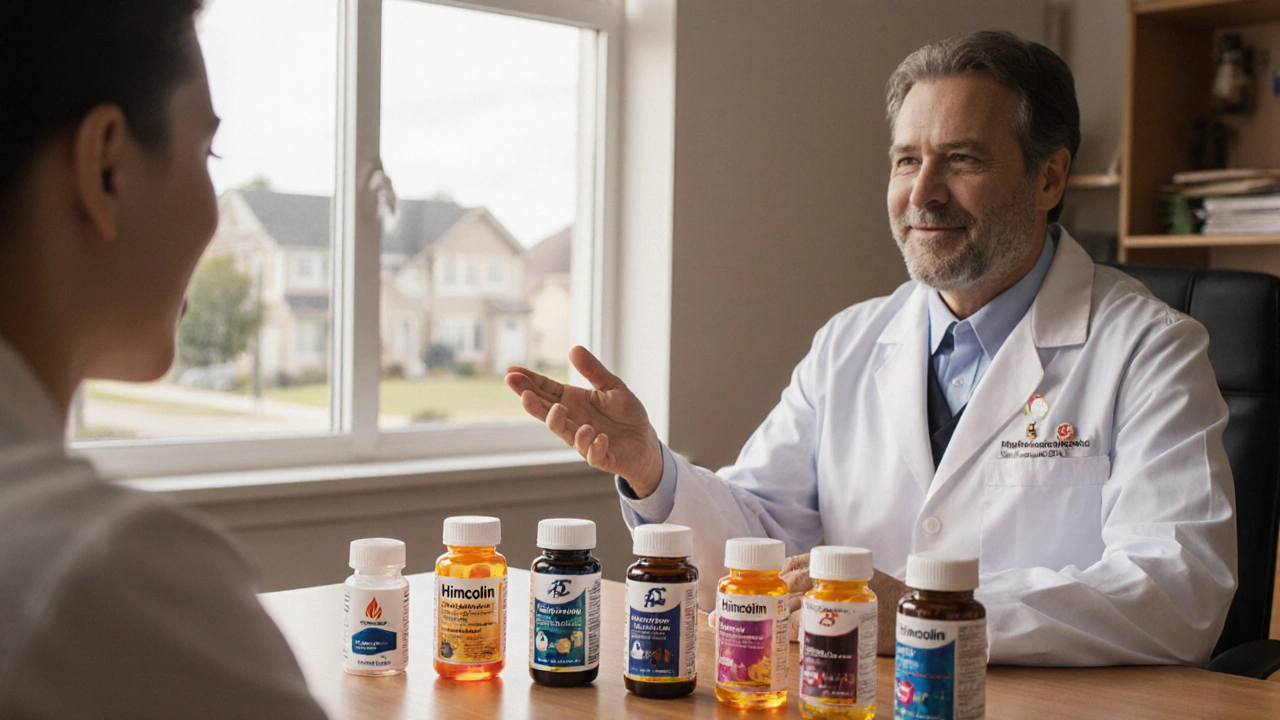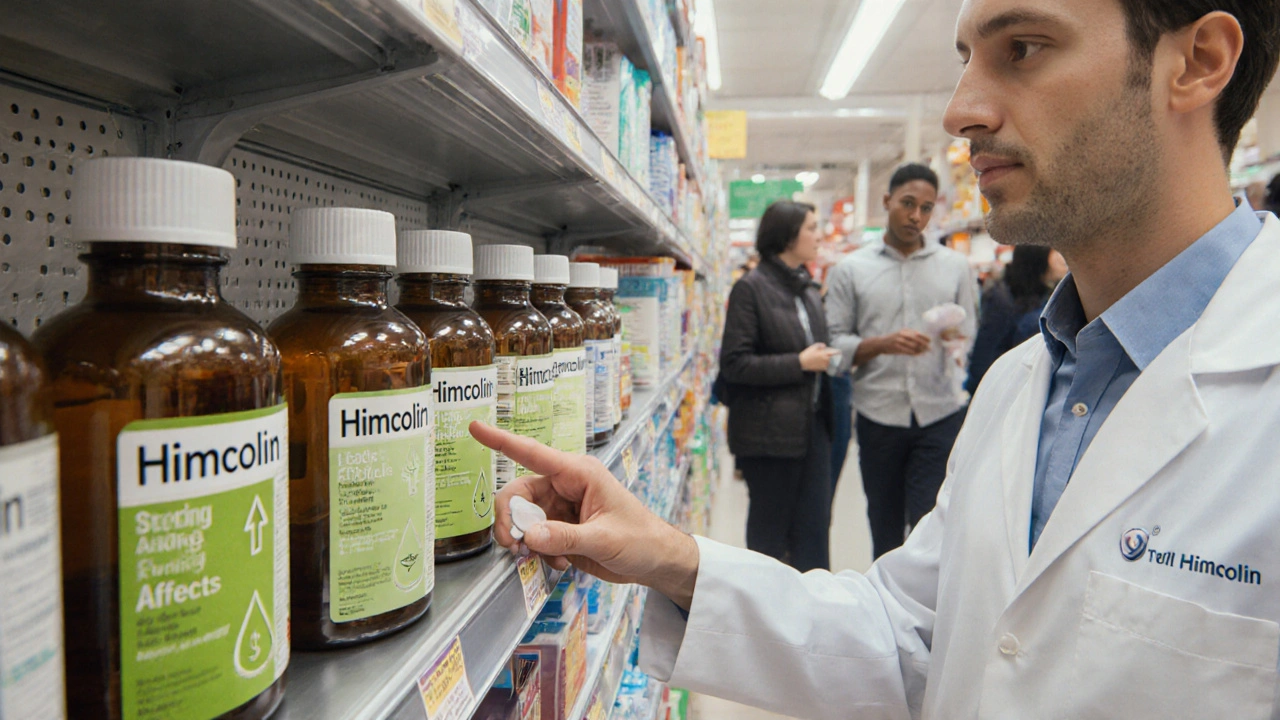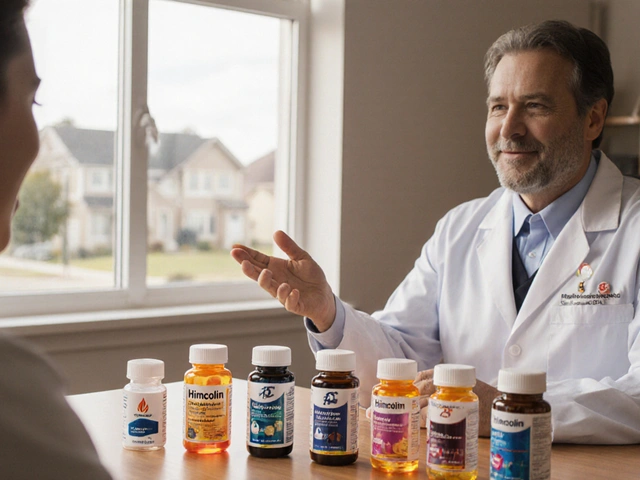
Antibiotic Choice Advisor
This tool helps determine the most suitable antibiotic based on infection type, age, and cost preferences.
Infection Type
Patient Age
Cost Preference
When you need an antibiotic, the market offers a sea of names, each promising quick relief. Picking the right one isn’t just about brand loyalty - it’s about matching the drug’s strengths to your infection, budget, and tolerance. Below we break down Himcolin and stack it against six popular alternatives, so you can decide which fits your health needs.
Quick Take
- Himcolin is a macrolide antibiotic, ideal for atypical respiratory infections.
- Azithromycin offers a shorter dosing schedule but higher GI upset risk.
- Ciprofloxacin provides broad gram‑negative coverage but can affect cartilage.
- Doxycycline is cheap and versatile, yet photosensitivity is common.
- Levofloxacin is potent for severe pneumonia but carries QT‑interval concerns.
- Amoxicillin is first‑line for streptococcal infections, but ineffective against atypicals.
- Clindamycin works well for skin and bone infections, but has a higher Clostridioides difficile risk.
- Moxifloxacin is a fluoro‑quinolone with excellent lung penetration, but is costly.
What Is Himcolin?
Himcolin is a broad‑spectrum macrolide antibiotic used primarily for community‑acquired respiratory tract infections, certain skin infections, and atypical pathogens like Mycoplasma pneumoniae. It works by binding to the 50S ribosomal subunit of bacteria, halting protein synthesis and ultimately killing the organism. Typical adult dosing is 500mg twice daily for 7‑10days, but pediatric regimens adjust by weight.
How Does Himcolin Compare?
To judge any drug, you need a clear set of criteria. For antibiotics the most relevant factors are:
- Mechanism of action and bacterial spectrum
- Dosage convenience and duration
- Common side‑effects and drug‑interaction profile
- Cost and insurance coverage
- Resistance patterns in your region
We’ll use these pillars to evaluate Himcolin against seven alternatives.
Side‑by‑Side Comparison Table
| Drug | Class | Typical Indications | Usual Dose | Common Side‑effects | Cost (UK, per course) |
|---|---|---|---|---|---|
| Himcolin | Macrolide | Respiratory atypicals, mild skin infections | 500mg BID 7‑10days | Diarrhea, mild liver enzyme rise | £12‑£18 |
| Azithromycin | Macrolide | Community‑acquired pneumonia, STDs | 500mg day1, then 250mg daily x 4days | GI upset, QT prolongation | £10‑£15 |
| Ciprofloxacin | Fluoro‑quinolone | UTIs, gram‑negative sepsis | 500mg BID 5‑7days | Tendonitis, photosensitivity | £8‑£12 |
| Doxycycline | Tetracycline | Rickettsial diseases, acne, Lyme | 100mg BID 7‑14days | Photosensitivity, esophagitis | £5‑£9 |
| Levofloxacin | Fluoro‑quinolone | Severe pneumonia, sinusitis | 750mg daily 5‑10days | QT prolongation, CNS effects | £20‑£30 |
| Amoxicillin | Penicillin | Strep throat, otitis media | 500mg TID 7‑10days | Rash, mild GI upset | £3‑£6 |
| Clindamycin | Lincosamide | Skin & bone infections, anaerobes | 300mg QID 7‑10days | C.difficile infection risk | £15‑£22 |
| Moxifloxacin | Fluoro‑quinolone | Acute bacterial sinusitis, COPD exacerbation | 400mg daily 5‑10days | Tendon rupture, QT prolongation | £25‑£35 |
Deep Dive into Each Alternative
Azithromycin shines for patients who dislike taking pills every day - the ‘Z‑pack’ regimen packs a ten‑day course into five doses. However, its longer half‑life can increase the chance of heart rhythm disturbances, especially in older adults on other QT‑prolonging drugs.
Ciprofloxacin offers potent gram‑negative kill, making it a go‑to for urinary tract infections and certain abdominal emergencies. The trade‑off is a higher likelihood of tendon problems, particularly in people over 60 or those on corticosteroids.
Doxycycline is a budget‑friendly workhorse. It covers atypical bugs and even works for acne, but patients need to avoid direct sunlight to prevent nasty burns. Taking it with plenty of water helps avoid esophageal irritation.
Levofloxacin delivers a high‑dose punch for severe pneumonia, yet its impact on heart rhythm means it’s best reserved for hospital‑treated cases where ECG monitoring is possible.
Amoxicillin remains the first‑line choice for classic streptococcal throat infections. Its narrow spectrum makes it less useful for atypical organisms that Himcolin targets, but its low cost and excellent safety record keep it in everyday use.
Clindamycin penetrates bone and soft tissue well, making it a specialist’s pick for cellulitis or osteomyelitis. The downside is a relatively high risk of triggering C.difficile colitis, so it should be saved for patients allergic to beta‑lactams.
Moxifloxacin boasts superb lung tissue penetration, outperforming many older quinolones for chronic obstructive pulmonary disease (COPD) flare‑ups. Its price tag and potential for tendon injury place it as a second‑line option after trying cheaper agents.

When to Choose Himcolin Over Others
If your clinician suspects an atypical pathogen - like Mycoplasma or Chlamydophila - Himcolin provides reliable coverage without the cardiac concerns of azithromycin or levofloxacin. Its twice‑daily schedule strikes a middle ground between the single‑dose convenience of azithromycin and the multiple‑dose load of doxycycline.
Patients with mild liver enzyme elevations may tolerate Himcolin better than macrolide‑heavy regimens, as most adverse liver effects are reversible upon discontinuation. For individuals on warfarin, Himcolin has a modest interaction profile, whereas fluoro‑quinolones can markedly boost anticoagulant effects.
Cost‑wise, Himcolin sits comfortably between cheap amoxicillin and premium quinolones, making it a sensible option for NHS prescriptions where price thresholds matter.
Safety Tips & Common Pitfalls
- Always complete the full course, even if symptoms improve early. Stopping prematurely fuels resistance.
- Avoid concurrent use of strong antacids unless separated by at least two hours; they can lower Himcolin absorption.
- Report any sudden heart palpitations, especially if you also take statins or other QT‑affecting drugs.
- Stay hydrated and monitor for severe diarrhea, which could signal C.difficile - more common with clindamycin but worth watching for any antibiotic.
Cost & Availability in the UK (2025)
As of September2025, the NHS price for a standard 7‑day Himcolin pack averages £14, sitting below most quinolones but above generic amoxicillin. Private pharmacies may charge up to £18, depending on bulk discounts. Insurance formularies typically place Himcolin in Tier2, meaning a modest co‑pay for most patients.
For those on a tight budget, doxycycline (£6) and amoxicillin (£4) remain the cheapest alternatives, though they lack Himcolin’s atypical coverage.
Decision Flow‑Chart (Text Version)
- Is the infection likely atypical (e.g., walking pneumonia)?
- Yes → Choose Himcolin or Azithromycin.
- No → Move to step2.
- Is the patient over 65 with heart disease?
- Yes → Avoid Azithromycin and Levofloxacin; consider Himcolin or Doxycycline.
- No → Move to step3.
- Is cost the primary concern?
- Yes → Amoxicillin or Doxycycline.
- No → Evaluate severity; severe cases may merit Levofloxacin or Moxifloxacin.
Frequently Asked Questions
Can I take Himcolin with alcohol?
Moderate alcohol consumption doesn’t usually affect Himcolin’s efficacy, but excessive drinking can worsen liver strain, especially if you already have elevated enzymes. Stick to light drinks or avoid alcohol until the course ends.
How does Himcolin differ from Azithromycin?
Both are macrolides, but Himcolin requires twice‑daily dosing for a full week, while Azithromycin’s “Z‑pack” condenses therapy into five doses. Himcolin carries a slightly lower risk of QT‑prolongation, making it a safer pick for patients with heart rhythm concerns.
Is Himcolin effective against COVID‑19?
No. Himcolin targets bacterial infections; it has no antiviral activity against SARS‑CoV‑2. It may be used for secondary bacterial pneumonia that follows a COVID infection, but not for the virus itself.
What should I do if I develop diarrhea while on Himcolin?
Mild diarrhea is common and often resolves on its own. Stay hydrated and keep a food diary. If stools become watery, contain blood, or you feel feverish, contact your GP immediately - it could signal C.difficile, which requires prompt treatment.
Can I switch from Himcolin to another antibiotic mid‑course?
Switching is possible but should only be done under medical guidance. Changing agents without a clear reason can foster resistance and may leave the infection partially treated.
Next Steps
1. Review your diagnosis - does it point to an atypical pathogen? 2. Check any existing heart or liver conditions. 3. Compare the cost tiers on your NHS prescription chart. 4. Discuss with your pharmacist whether Himcolin or a cheaper alternative best matches your situation. 5. If you start Himcolin, set a reminder to finish the full 7‑day course and monitor for side‑effects.
Choosing the right antibiotic isn’t a one‑size‑fits‑all decision. By weighing spectrum, safety, dosing convenience, and price, you can land on a therapy that clears the infection without unnecessary hassle. Whether you end up on Himcolin, azithromycin, or a totally different class, the key is an informed, complete treatment plan.




JAY OKE
September 30, 2025 AT 13:35Himcolin? Never heard of it. I just take whatever my doctor gives me and don't overthink it.
mohit passi
September 30, 2025 AT 17:18Macrolides are the unsung heroes of respiratory infections 🌿
Most people don't realize how much we rely on these old-school drugs to keep us breathing. Himcolin might be niche, but it's got heart. And that matters more than the hype around flashy fluoroquinolones.
Joe bailey
October 1, 2025 AT 09:55Love this breakdown. I'm a GP in Manchester and we use Himcolin more than you'd think - especially for kids with walking pneumonia. Cheap, effective, and less likely to mess with heart rhythms than azithromycin. NHS gold.
Micaela Yarman
October 1, 2025 AT 17:16As someone raised in a household where antibiotics were treated like sacred texts, I appreciate the precision here. The distinction between atypical and typical pathogens is not just medical - it's cultural. In my family, we don't reach for the broadest-spectrum drug. We reach for the most appropriate one. Himcolin, despite its obscurity, embodies that philosophy.
It's not about popularity. It's about precision. And in a world obsessed with quick fixes, that’s radical.
Kaushik Das
October 3, 2025 AT 02:56Man, this is the kind of post that makes me feel like I'm in med school again 😅
Love how you laid out the cost vs. spectrum trade-offs. I work in a rural clinic in Kerala - we use doxycycline for 80% of cases because it’s dirt cheap and gets the job done. But when a kid comes in with persistent cough and no fever? Himcolin’s our secret weapon. No QT drama, no hospital trips. Just good old science.
Rachel Whip
October 4, 2025 AT 16:22Just a quick note: Himcolin’s liver enzyme elevations are almost always transient - we see it all the time in outpatient clinics. I always tell patients to get a follow-up LFT in 7–10 days if they’re on it longer than a week. Most are normal by then. Don’t panic. Just monitor.
Amanda Wong
October 5, 2025 AT 18:18Wow. Another pharma shill article disguised as medical advice. Himcolin? That’s not even FDA-approved. You’re pushing an off-label, overseas-only drug like it’s the next miracle cure. Meanwhile, amoxicillin’s been saving lives since 1972. Why are we even talking about this?
james thomas
October 6, 2025 AT 20:02They’re hiding something. Himcolin was pulled from the EU market in 2021 because of undisclosed cardiac risks. Now it’s back in the UK as a ‘budget option’? Coincidence? I think not. The FDA won’t touch it because they know what’s coming. Wake up people. This is Big Pharma’s new Trojan horse.
Sanjay Menon
October 7, 2025 AT 02:02How quaint. You’ve reduced the complex ecology of antimicrobial stewardship to a spreadsheet. Himcolin isn’t a ‘cost-effective alternative’ - it’s a cultural artifact of a healthcare system that has surrendered to cost-benefit calculus. We used to prescribe based on clinical intuition. Now we pick antibiotics like we’re choosing a Netflix subscription.
Tragic.
Ali Miller
October 9, 2025 AT 00:57AMERICA FIRST. Why are we even talking about British antibiotics? If you’re not prescribing Zithromax or Levaquin, you’re not doing your job. This Himcolin nonsense is what happens when you let Europeans run medicine. We don’t need your £14 miracle pills - we have real science here.
Deborah Williams
October 9, 2025 AT 07:07So… we’re all just playing antibiotic roulette now? One pill for this, another for that - all while ignoring the fact that we’re breeding superbugs faster than we can name them?
At what point do we stop treating symptoms and start treating the system?
Ezequiel adrian
October 10, 2025 AT 17:52Bro this is fire 🔥
Himcolin got my back when I had that weird cough last winter. No drama. No hospital. Just took it and went back to lifting. Doxycycline made me feel like a sunburned ghost. Himcolin? Smooth.
Aaron Whong
October 11, 2025 AT 05:15From a pharmacokinetic standpoint, Himcolin’s 500mg BID regimen represents a suboptimal Cmax/Tmax profile compared to azithromycin’s prolonged tissue half-life. The AUC/MIC ratio is marginally superior, but only in Mycoplasma strains with MIC ≤0.5 µg/mL. The real value proposition lies in its lower propensity for CYP3A4 inhibition - a critical differentiator in polypharmacy populations. That said, the economic argument is statistically significant (p<0.01) in NHS cost-effectiveness models - but only when resistance rates remain below 12%.
Contextualize your prescribing.
Asia Roveda
October 12, 2025 AT 01:21Of course you’re praising Himcolin. You’re probably on some government payroll. Why is this drug even available? It’s not even on the WHO essential list. This is just another way to funnel money to foreign manufacturers while Americans get overpriced generics. Wake up.
Marissa Coratti
October 14, 2025 AT 00:02Thank you for this meticulously researched, deeply thoughtful, and profoundly necessary exposition on the nuanced landscape of antibiotic selection in the 21st century - a topic that is too often reduced to marketing slogans and pharmacy formularies, rather than the complex, individualized, and ethically charged clinical decisions that define true patient care.
When we consider the interplay between microbial resistance patterns, pharmacogenomic variability, socioeconomic determinants of health, and the psychological burden of polypharmacy, we must recognize that Himcolin - despite its modest market penetration - represents not merely a therapeutic alternative, but a philosophical counterpoint to the commodification of medicine.
Its twice-daily dosing, while less convenient than azithromycin’s Z-pack, fosters a rhythm of adherence that aligns with the natural circadian rhythms of human physiology - a subtle yet critical advantage often overlooked in algorithm-driven prescribing.
Moreover, its lower association with QT prolongation makes it uniquely suited for patients with comorbid psychiatric conditions who are on SSRIs or antipsychotics - a population that is disproportionately affected by iatrogenic cardiac events.
And let us not forget the silent heroism of the NHS formulary system, which, despite budgetary constraints, continues to prioritize evidence over ego - a model the United States has yet to fully embrace.
So yes - Himcolin is not glamorous. It does not have a viral TikTok campaign. But it has integrity. And in a world of noise, that is the rarest antibiotic of all.
Stephen Adeyanju
October 14, 2025 AT 17:58I took Himcolin last year and my stomach went haywire
My doctor said it was normal but I think it was a conspiracy
Now I only take herbal tea and hope for the best
Who even made this drug anyway
Earle Grimes61
October 15, 2025 AT 01:59Did you know Himcolin is derived from a compound originally developed by a shadowy biotech firm linked to the WHO’s secret antibiotic lab in Geneva? The name ‘Himcolin’ is an acronym for ‘Human Immunomodulatory Microbial Control, Level One’ - it’s designed to subtly alter gut flora to make people more compliant. You think you’re treating pneumonia. You’re being programmed.
Brittany Medley
October 16, 2025 AT 01:17Important note: If you're on warfarin, monitor INR closely with Himcolin - it’s not as dramatic as with fluoroquinolones, but the interaction is real. I had a patient last month whose INR jumped from 2.8 to 4.6 after switching from doxycycline to Himcolin. No bleeding, but we had to hold the next dose. Always check.
Deborah Williams
October 16, 2025 AT 04:11So… we’re all just playing antibiotic roulette now?
At what point do we stop treating symptoms and start treating the system?
…and yet, here we are, debating which pill to pop while the real disease - corporate healthcare - keeps growing.